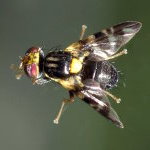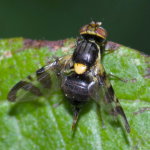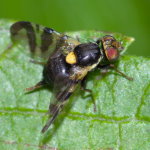Phylum Arthropoda (Arthropods) ➔ Subphylum Hexapoda (Hexapods) ➔ Class Insecta (Insects) ➔ Order Diptera (True flies) ➔ Family Tephritidae (Fruit flies)
Rhagoletis cerasi (Linnaeus, 1758)
Kirschfruchtfliege Cherry Fruit Fly
Synonyms and other combinations:
Musca cerasi Linnaeus, 1758 | Rhagoletis fasciata Rohdendorf, 1961 | Rhagoletis nigripes Rohdendorf, 1961 | Rhagoletis obsoleta Hering, 1936 | Tephritis ceraci Persson, 1958 | Trypeta signata Meigen, 1826 | Urophora cerasorum Dufour, 1845 | Urophora liturata Robineau-Desvoidy, 1830 |
Further vernacular names:
European Cherry Fruit FlyClassification:
Rhagoletis cerasi belongs to the subfamily Trypetinae, tribe Carpomyini.Distribution:
Europe, AsiaDescription:
The Cherry Fruit Fly Rhagoletis cerasi has a body length of 4 - 5 mm. The scutellum is yellow. The wings show a characteristic dark pattern.The white larvae grow up to 6 mm long. The size of the pupae is 3 - 4 mm.
Biology:
The imagines of the Cherry Fruit Fly Rhagoletis cerasi fly in one generation from mid-May to the end of July.Host plants of the Cherry Fruit Fly are different species of the genera Prunus (Rosaceae: P. cerasus, P. avium, P. serotina, P. mahaleb) and Lonicera (Caprifoliaceae: L. xylosteum, L. tatarica, L. alpigena). About 2 weeks after flowering, the females of the Cherry Fruit Fly begin to lay their eggs in the ripening fruits. Normally only one egg is laid per fruit,. A marker pheromone is used to inform subsequent females that the fruit is already occupied and thus prevents the laying of further eggs in the same fruit. Approximately 10 days after laying the eggs, the larvae hatch. These feed on the pulp near the stone for about 3 weeks. The adult larvae leave the fruit, fall to the ground and pupate at a depth of 2 to 3 cm. The pupae hibernate. The new generation hatches in May. A small part of the pupae can also survive longer in the ground and only hatch in the following years.
Note:
Since the larvae of Rhagoletis cerasi develop in cherries, their occurrence can lead to large losses in the cultivation of sweet cherries.References, further reading, links:
- Pape T. & Thompson F.C. (eds) (2017). Systema Dipterorum (version 2.0, Jan 2011). In: Species 2000 & ITIS Catalogue of Life, 2017 Annual Checklist (Roskov Y., Abucay L., Orrell T., Nicolson D., Bailly N., Kirk P.M., Bourgoin T., DeWalt R.E., Decock W., De Wever A., Nieukerken E. van, Zarucchi J., Penev L., eds.). Digital resource at www.catalogueoflife.org/annual-checklist/2017. Species 2000: Naturalis, Leiden, the Netherlands. ISSN 2405-884X.
- Claudia Daniel, and Jürg Grunder: Integrated Management of European Cherry Fruit Fly Rhagoletis cerasi (L.): Situation in Switzerland and Europe, Insects 2012, 3, 956-988; doi:10.3390/insects304095.6.
- Acidia cognata
- Chaetostomella cylindrica
- Myopites sp.
- Myopites stylatus
- Philophylla caesio
- Tephritis vespertina
- Terellia serratulae
- Trupanea amoena
- Trupanea guimari
- Banded Burdock Fly
- Bull Thistle Gall Fly
- Bur-marigold Fly
- Canada Thistle Gall Fly
- Cherry Fruit Fly
- Clouded Wormwood Fly
- Daisy Leafminer
- Four-barred Knapweed Gall Fly
- Mediterranean Fruit Fly
- Melancholy Thistle Fly
- Mottled Thistle Fly
- Rayed Thistle Fly
- Red-tailed Thistle Fly
- Sonchus Fly
- Spectacled Berry Fly


